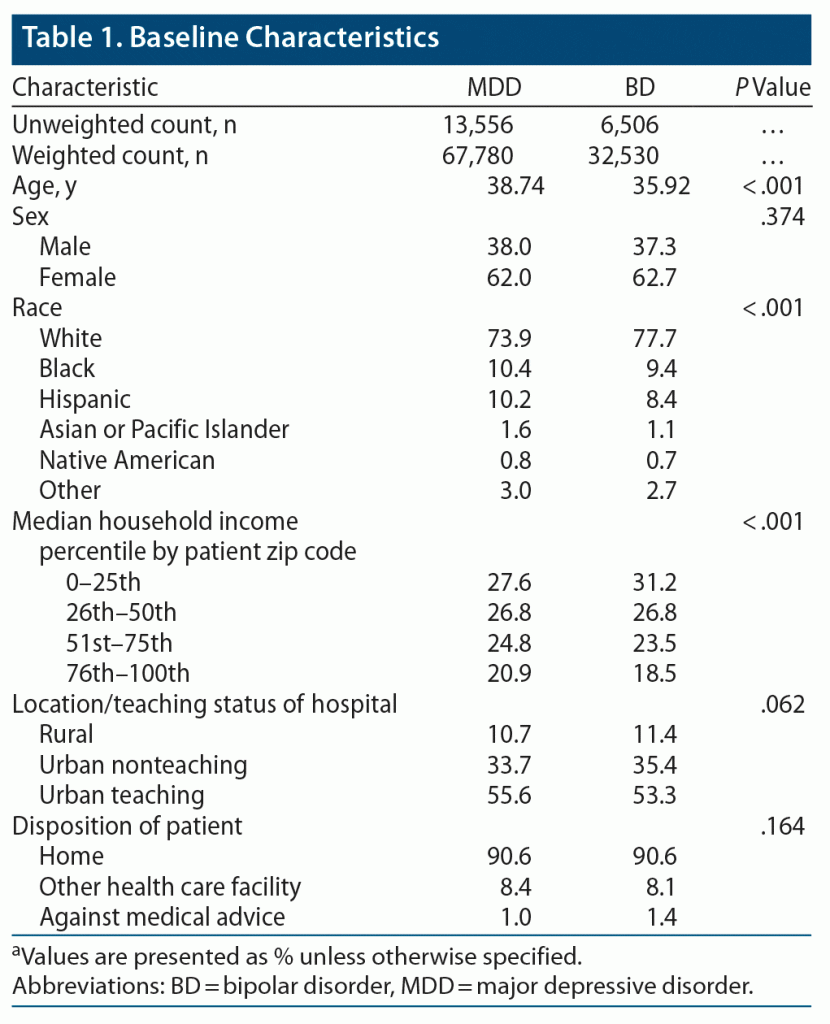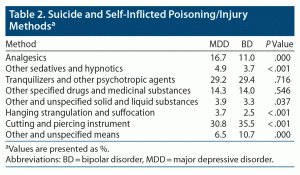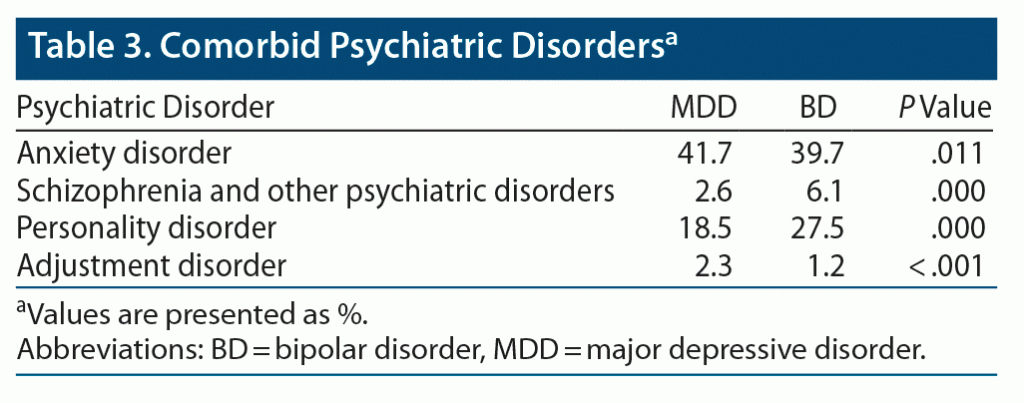ABSTRACT
Objective: Individuals with major depressive disorder (MDD) and bipolar disorder (BD) are at increased risk of suicide. The objective of this study was to examine the prevalence of different methods of suicide and self-inflicted poisoning/injury in individuals with MDD or BD.
Methods: This study used a US National Inpatient Sample dataset from years 2012–2015. Data were collected from discharge records of patients aged ≥ 18 years admitted for MDD or BPD. The prevalence of different methods of suicide and self-inflicted poisoning/injury was evaluated. Highly prevalent subtypes of depression and bipolar disorder among the 2 groups were investigated, and psychiatric comorbidities were compared.
Results: We identified 13,556 unweighted records of patients admitted to the hospital for MDD diagnosis, and 6,506 unweighted records of patients admitted for BD diagnosis. Suicide and self-inflicted poisoning/injury by cutting instrument was highly prevalent among both groups, with a greater prevalence among patients with BD compared to MDD (35.5% vs 30.8%, P < .001). Use of tranquilizers/other psychotropic agents (29.2% vs 29.4%, P = .72) and other specified drugs and medicinal substances (14.3% vs 14.0%, P = .546) was high among both groups; however, there was no significant difference. Analgesics (16.7% vs 11%, P = .000), other sedatives and hypnotics (4.9% vs 3.7%, P < .001), other and unspecified solid and liquid substances (3.9% vs 3.3%, P = .037), and hanging by strangulation and suffocation (3.7% vs 2.5%, P < .001) were more prevalent in patients in the MDD group.
Conclusions: The results indicate that it is critical to investigate and understand the methods used by individuals with MDD and BD to commit suicide. Restricting access to the most prevalent forms of self-injury could be a practical suicide prevention approach.
Prim Care Companion CNS Disord 2022;24(4):21m03159
To cite: Vadukapuram R, Trivedi C, Mansuri Z, et al. Common methods of suicide and self-inflicted poisoning/injury by individuals with major depressive disorder and bipolar disorder: a nationwide inpatient sample analysis. Prim Care Companion CNS Disord. 2022;24(4):21m03159.
To share: https://doi.org/10.4088/PCC.21m03159
© 2022 Physicians Postgraduate Press, Inc.
aDepartment of Psychiatry, The University of Texas Rio Grande Valley, Harlingen, Texas
bTexas Tech University Health Science Center at Permian Basin, Midland, Texas
cBoston Children’s Hospital/Harvard Medical School, Boston, Massachusetts
‡Drs Vadukapuram and Trivedi share equal credits for first authorship. Drs Mansuri and Jain share equal credits for senior authorship.
*Corresponding author: Ramu Vadukapuram, MD, Department of Psychiatry, The University of Texas Rio Grande Valley, 2102 Treasure Hills Blvd, Harlingen, TX 78550 ([email protected]).
Suicide is the intentional infliction of bodily harm on oneself to die. A suicide attempt occurs when a person harms themselves, intending to end their life but not die because of their actions.1 Suicide is the second leading cause of death in individuals aged 10 to 14 years and aged 25 to 34 years, the fourth leading cause in those aged 35 to 44 years, the seventh leading cause in those aged 45 to 54 years, and the twelfth leading cause of death among all ages.2
In 2019, the United States witnessed 47,511 suicide deaths and 1.38 million suicide attempts.3 American Indian/Alaska Native and non-Hispanic White populations have the highest rates.4 Compared to their straight peers, young people who identify as lesbian, gay, or bisexual have a higher percentage of suicidal ideation and behavior.5 There are risk and protective factors associated with either increased or decreased risk of suicide. Previous suicide attempts, mental illness, social isolation, and people who have witnessed violence, including child abuse, bullying, or sexual violence, are at a higher risk of committing suicide.6 On the other hand, protective factors such as being connected to family and community support and having easy access to health care and a supportive relationship with the care provider could reduce the risk of suicidal thoughts and behaviors.7 Most suicides worldwide are associated with psychiatric disorders, with mood disorders, substance abuse, and psychotic disorders being the most significant risk factors.8
The risk of suicide among patients with major depressive disorder (MDD) and bipolar disorder (BD) is over 30 times higher than in the general population.9 Depression is the leading cause of disability worldwide, accounting for a significant portion of the global disease burden.10 In a year, approximately 17.3 million American adults, or about 7.1% of the US population aged ≥ 18 years, suffer from MDD.11 In addition, every year, approximately 5.7 million US adults, or about 2.6% of the US population aged ≥ 18 years, have BD.12
Men were found more likely to complete suicide and to use more violent suicide techniques.13 In contrast, women were more likely to attempt suicide.13 Failed attempts at suicide that are well planned, drastic, or violent have a higher likelihood of a subsequent successful effort.14 Runeson et al15 found that suicide by hanging, drowning, shooting with a handgun, or jumping from a great height has a much higher likelihood of accomplishment in the short and long term.15
Over a 5- to 35-year follow-up period, the probability of suicide following an unsuccessful attempt is roughly 10%.16,17 Identification of the suicide predictive factors in MDD and BD patients is essential to prevent suicide. It is equally important to determine the methods by which patients try to end their lives. Identification of this information could help prevent the future actions of these vulnerable patients. This study used a US nationwide inpatient sample dataset to understand and explore different suicide and self-inflicted poisoning/injury methods used by MDD and BD patients.
METHODS
Data Source
The National Inpatient Sample (NIS) dataset for 2012–2015 was used to obtain the study population. The NIS is one of the largest inpatient databases from the Healthcare Cost and Utilization Project (HCUP), which covers 4,411 hospitals in 45 states in the United States.18 The dataset is a sample of discharges from all the hospitals taking part in HCUP, roughly a 20% stratified sample (approximately over 7 million hospitalizations each year) of all discharges from community hospitals in the United States, excluding rehabilitation and long-term acute care hospitals.
Study Population
We collected data on patients aged ≥ 18 years admitted for MDD and BD from discharge records. We identified BD and MDD patients using International Classification of Diseases 10th Revision Clinical Modification (ICD-10-CM) codes (Supplementary Table 1).
Outcomes
Suicide and self-inflicted poisoning/injury methods were the primary outcomes between the groups. The secondary outcomes were psychiatric comorbidities between the groups. We obtained both sets of outcomes data using the ICD code provided in the NIS dataset clinical classifications software.
Variables
Data on age, sex, race, median household income, location/teaching status of the hospital, and discharge disposition were collected from the dataset and compared between the BD and MDD groups.
Statistical Analysis
A descriptive analysis was carried out, and categorical data are presented as a percentage. Mean and standard error are used to present continuous data. The independent sample t test and the Rao-Scott adjusted χ2 test were used to compare groups.
A P value < .05 was considered statistically significant for all statistical analyses. All analyses were conducted using the complex survey data analysis technique, with appropriate NIS stratum, hospital identification code, and discharge weight variables from the NIS dataset to represent our sample population nationally. All analyses were conducted using SPSS version 26.0 (IBM Software, Armonk, New York).19
RESULTS
Baseline Characteristics
We identified 13,556 unweighted records of patients admitted to the hospital for MDD diagnosis and 6,506 for BD diagnosis (Table 1). The mean age of the patients in the MDD group was higher than that of the BD group (mean age of 38.74 vs 35.92). Female sex (62.0% vs 62.7%, P = .374) and White race (73.9% vs 77.7%, P < .001) were higher in both groups. However, there was no statistical difference between the groups. Patients with MDD and BD were more likely to be admitted to the hospital in areas wherein the median household income was in the 0 to 25th percentile (27.6% vs 31.2%, P < .001), followed by the 26th to 50th percentile. Hospital admissions were higher in the urban teaching hospitals among both groups (55.6% vs 53.3%, P = .062). Most patients in both groups were discharged to their homes, and there was no difference between the groups (90.6% vs 90.6%, P = .164).
Suicide and Self-Inflicted Poisoning/Injury
Suicide and self-inflicted poisoning/injury by cutting and piercing instruments was highly prevalent among both groups, with a greater prevalence among patients with BD compared to MDD (35.5% vs 30.8%, P < .001) (Table 2). Use of tranquilizers/other psychotropic agents (29.2% vs 29.4%, P = .72) and other specified drugs and medicinal substances (14.3% vs 14.0%, P = .546) were high among both groups; however, there was no significant difference between the groups. Analgesics (16.7% vs 11%, P = .000), other sedatives and hypnotics (4.9% vs 3.7%, P < .001), other and unspecified solid and liquid substances (3.9% vs 3.3%, P = .037), and hanging by strangulation and suffocation (3.7% vs 2.5%, P < .001) were used more in patients in the MDD group compared to the BD group.
Psychiatric Comorbidities
Prevalence of anxiety disorders (41.7% vs 39.7%, odds ratio [OR] = 0.920, CI, 0.864–0.981, P = .011) and adjustment disorders (2.3% vs 1.2%, OR = 0.498, CI, 0.386–0.644, P < .001) was higher in the MDD group compared to the BD group (Table 3). Prevalence of schizophrenia and other psychotic disorders (6.1% vs 2.6%, OR = 2.486, CI, 2.125–2.909, P = .000) and personality disorders (27.5% vs 18.5%, OR = 1.670, CI, 1.548–1.802, P = .000) was higher in BD patients compared to MDD patients.
DISCUSSION
This study is the first, to our knowledge, to explore the common methods of suicide and self-inflicted poisoning/injury by individuals with MDD and BD using a large nationwide inpatient database. In this study, the patients in the MDD group were older on average than those in the BD group. Both groups had more female and White patients, but there was no difference between them. In places where the median household income was in the 0–25th percentile, patients with MDD and BD were more likely to be admitted to the hospital, followed by the 26th to 50th percentile. Hospital admissions were higher in urban teaching hospitals than in urban nonteaching and rural hospitals in both groups. Most patients were discharged to their homes compared to other health care facilities in both groups.
In our study, suicide and self-inflicted poisoning/injury by cutting and piercing instruments was common in both categories, with BD patients having a higher frequency than MDD patients. MDD patients used more analgesics, other sedatives and hypnotics, other and unspecified solid and liquid medications, and hanging by strangulation and suffocation than those in the BD group.
MDD and BD were linked to other psychiatric comorbidities in our study. Anxiety problems were more common in the MDD group than in the BD group. In BD patients, the prevalence of schizophrenia and other psychotic illnesses and personality disorders was higher than in MDD patients. We also investigated subtypes of MDD and BD in both groups.
Shippee et al20 investigated a nationally representative sample and observed that individuals with BD were often younger, unmarried, poorer (particularly in the lowest income category), more likely to live alone, and less educated than those diagnosed with depressive illnesses (with a lower proportion holding at least a college degree). They also found significantly more White females in both mood disorder groups (MDD and BD) compared to the non–mood disorder group.20 Comparably, the MDD patients in this study were, on average, older than the BD patients. In addition, patients with MDD and BD were more likely to be admitted to the hospital in regions where the median family income was in the 0 to 25th percentile, followed by the 26th to 50th percentile. Female sex and White race were higher in both groups, but there was no difference between them.20
Baldessarini et al21 found that compared to depression, patients with bipolar illness had a higher lifetime risk of suicidal ideation (29.2% vs 17.3%) attempted suicide (18.8% vs 4.78%), and suicide (1.73% vs 0.48%). Similarly, suicide and self-inflicted poisoning/injury with cutting and piercing instruments was shown to be common in both BD and MDD patients in this study, with BD patients having a higher incidence than MDD patients.
Thaipisuttikul et al,22 in a cross-sectional study, observed that MDD was linked to anxiety disorders, substance abuse problems, and other depressive disorders. Similarly, we observed that anxiety problems were more common in the MDD group than in the BD group in our study.
Strengths and Limitations
The strengths of this study include analysis of a nationally representative cohort of patients with MDD and BD. Retrospective studies are prone to detection, reporting, and coding bias, whether utilizing chart review at academic institutions, secondary consideration of clinical trial data, or hospital claims data. In addition, because our research relies on a deidentified administrative database, it is vulnerable to coding errors that cannot be confirmed individually. Finally, the same patients were likely counted more than once because the records in the dataset are discharge records rather than individual patients.
CONCLUSION
According to our findings, individuals with mood disorders who attempt suicide by analgesics, other sedatives and hypnotics, hanging by strangulation and suffocation, self-inflicted injury by cutting and piercing instruments, and other unspecified means are at risk of suicide in the short and long term. Those who attempt suicide using highly lethal techniques are more likely to use the same approach in their irrevocable act of suicide. Future studies should focus on suicide attempts to reduce risk and provide high-quality care for these vulnerable patient populations.
Submitted: September 28, 2021; accepted November 24, 2021.
Published online: August 16, 2022.
Relevant financial relationships: None.
Funding/support: None.
Supplementary material: See accompanying pages.
Clinical Points
- Suicide and self-inflicted poisoning/injury by cutting and piercing instruments was common in both patient groups, with bipolar patients having a higher frequency than those with major depressive disorder.
- It is important to investigate and understand the methods used to commit suicide because restricting access to these most prevalent forms of self-injury could be a practical approach to suicide prevention.
References (22)

- Crosby AE, Ortega L, Melanson C. Self-Directed Violence Surveillance: Uniform Definitions and Recommended Data Elements, Version 1.0. Atlanta, GA: Centers for Disease Control and Prevention, National Center for Injury Prevention and Control; 2011.
- NIMH ” Suicide. NIMH website. Accessed May 6, 2021. https://www.nimh.nih.gov/health/statistics/suicide
- Suicide Statistics American Foundation for Suicide Prevention. AFSP website. Accessed July 21, 2021. https://afsp.org/suicide-statistics/
- WISQARS. (Web-based Injury Statistics Query and Reporting System). Injury Center. Centers for Disease Control and Prevention. Accessed August 6, 2021. https://www.cdc.gov/injury/wisqars/index.html
- Ivey-Stephenson AZ. Suicidal Ideation and Behaviors Among High School Students — Youth. Centers for Disease Control and Prevention. Accessed August 20, 2020. https://www.cdc.gov/mmwr/volumes/69/su/su6901a6.htm?s_cid=su6901a6_w
- Park CHK, Lee JW, Lee SY, et al. Suicide risk factors across suicidal ideators, single suicide attempters, and multiple suicide attempters. J Psychiatr Res. 2020;131:1–8. PubMed CrossRef
- Preventing Multiple Forms of Violence. A Strategic Vision for Connecting the Dots. Atlanta, GA: Division of Violence Prevention, National Center for Injury Prevention and Control. Centers for Disease Control and Prevention; 2016.
- Bachmann S. Epidemiology of suicide and the psychiatric perspective. Int J Environ Res Public Health. 2018;15(7):1425. PubMed CrossRef
- Guze SB, Robins E. Suicide and primary affective disorders. Br J Psychiatry. 1970;117(539):437–438. PubMed CrossRef
- World Health Statistics 2017: Monitoring Health for the SDGs, Sustainable Development Goals. Geneva. World Health Organization; 2017.
- National Institute of Mental Health. Major Depression. NIMH website. Accessed July 21, 2021. https://www.nimh.nih.gov/health/statistics/major-depression
- National Institute of Mental Health. Bipolar Disorder. NIMH website. Accessed July 21, 2021. https://www.nimh.nih.gov/health/topics/bipolar-disorder/
- Tsirigotis K, Gruszczynski W, Tsirigotis M. Gender differentiation in methods of suicide attempts. Med Sci Monit. 2011;17(8):PH65–PH70. PubMed CrossRef
- Mann JJ, Apter A, Bertolote J, et al. Suicide prevention strategies: a systematic review. JAMA. 2005;294(16):2064–2074. PubMed CrossRef
- Runeson B, Tidemalm D, Dahlin M, et al. Method of attempted suicide as predictor of subsequent successful suicide: national long term cohort study. BMJ. 2010;341(jul13 1):c3222. PubMed CrossRef
- Suokas J, Suominen K, Isometsä E, et al. Long-term risk factors for suicide mortality after attempted suicide: findings of a 14-year follow-up study. Acta Psychiatr Scand. 2001;104(2):117–121. PubMed CrossRef
- Suominen K, Isometsä E, Suokas J, et al. Completed suicide after a suicide attempt: a 37-year follow-up study. Am J Psychiatry. 2004;161(3):562–563. PubMed CrossRef
- HCUP-US NIS Overview. Healthcare Cost and Utilization Project (HCUP). HCUP website. Accessed July 20, 2021. https://www.hcup-us.ahrq.gov/nisoverview.jsp
- IBM SPSS Statistics 26. IBM website. Accessed July 20, 2021. https://www.ibm.com/support/pages/downloading-ibm-spss-statistics-26
- Shippee ND, Shah ND, Williams MD, et al. Differences in demographic composition and in work, social, and functional limitations among the populations with unipolar depression and bipolar disorder: results from a nationally representative sample. Health Qual Life Outcomes. 2011;9(1):90. PubMed CrossRef
- Baldessarini RJ, Tondo L, Pinna M, et al. Suicidal risk factors in major affective disorders. Br J Psychiatry. 2019;215(4):1–6. PubMed CrossRef
- Thaipisuttikul P, Ittasakul P, Waleeprakhon P, et al. Psychiatric comorbidities in patients with major depressive disorder. Neuropsychiatr Dis Treat. 2014;10:2097–2103. PubMed CrossRef
Please sign in or purchase this PDF for $40.







